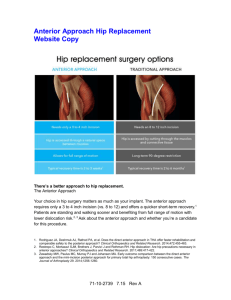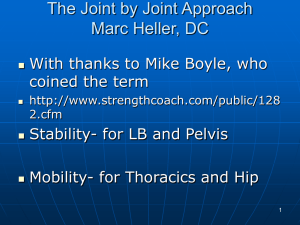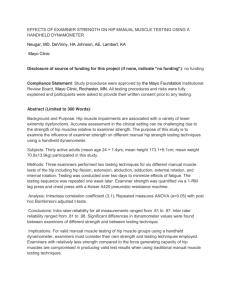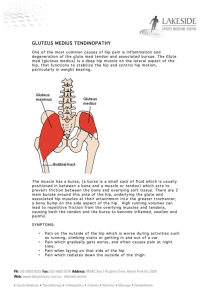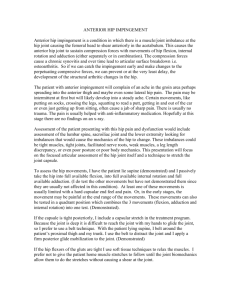Gluteus Minimus Referral Pattern
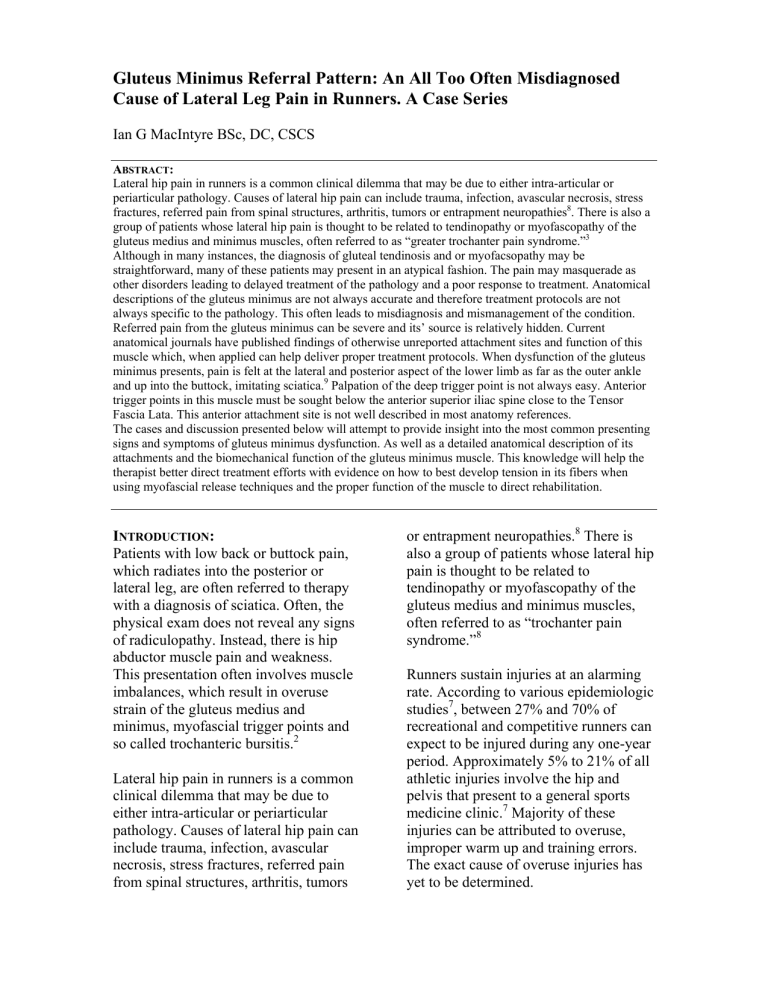
Gluteus Minimus Referral Pattern: An All Too Often Misdiagnosed
Cause of Lateral Leg Pain in Runners. A Case Series
Ian G MacIntyre BSc, DC, CSCS
A BSTRACT :
Lateral hip pain in runners is a common clinical dilemma that may be due to either intra-articular or periarticular pathology. Causes of lateral hip pain can include trauma, infection, avascular necrosis, stress fractures, referred pain from spinal structures, arthritis, tumors or entrapment neuropathies
8
. There is also a group of patients whose lateral hip pain is thought to be related to tendinopathy or myofascopathy of the gluteus medius and minimus muscles, often referred to as “greater trochanter pain syndrome.”
3
Although in many instances, the diagnosis of gluteal tendinosis and or myofacsopathy may be straightforward, many of these patients may present in an atypical fashion. The pain may masquerade as other disorders leading to delayed treatment of the pathology and a poor response to treatment. Anatomical descriptions of the gluteus minimus are not always accurate and therefore treatment protocols are not always specific to the pathology. This often leads to misdiagnosis and mismanagement of the condition.
Referred pain from the gluteus minimus can be severe and its’ source is relatively hidden. Current anatomical journals have published findings of otherwise unreported attachment sites and function of this muscle which, when applied can help deliver proper treatment protocols. When dysfunction of the gluteus minimus presents, pain is felt at the lateral and posterior aspect of the lower limb as far as the outer ankle and up into the buttock, imitating sciatica.
9
Palpation of the deep trigger point is not always easy. Anterior trigger points in this muscle must be sought below the anterior superior iliac spine close to the Tensor
Fascia Lata. This anterior attachment site is not well described in most anatomy references.
The cases and discussion presented below will attempt to provide insight into the most common presenting signs and symptoms of gluteus minimus dysfunction. As well as a detailed anatomical description of its attachments and the biomechanical function of the gluteus minimus muscle. This knowledge will help the therapist better direct treatment efforts with evidence on how to best develop tension in its fibers when using myofascial release techniques and the proper function of the muscle to direct rehabilitation.
I NTRODUCTION :
Patients with low back or buttock pain, which radiates into the posterior or lateral leg, are often referred to therapy with a diagnosis of sciatica. Often, the physical exam does not reveal any signs of radiculopathy. Instead, there is hip abductor muscle pain and weakness.
This presentation often involves muscle imbalances, which result in overuse strain of the gluteus medius and minimus, myofascial trigger points and so called trochanteric bursitis.
2
Lateral hip pain in runners is a common clinical dilemma that may be due to either intra-articular or periarticular pathology. Causes of lateral hip pain can include trauma, infection, avascular necrosis, stress fractures, referred pain from spinal structures, arthritis, tumors or entrapment neuropathies.
8 pain is thought to be related to tendinopathy or myofascopathy of the gluteus medius and minimus muscles, often referred to as “trochanter pain syndrome.”
8
Runners sustain injuries at an alarming rate. According to various epidemiologic studies
7
, between 27% and 70% of recreational and competitive runners can expect to be injured during any one-year period. Approximately 5% to 21% of all athletic injuries involve the hip and pelvis that present to a general sports medicine clinic.
7
Majority of these injuries can be attributed to overuse, improper warm up and training errors.
The exact cause of overuse injuries has yet to be determined.
There is also a group of patients whose lateral hip
Sports medicine literature commonly ascribes overuse injuries in runners to three general categories. The first category being training errors, including improper running shoes, excessive distances or intensities and a rapid increase in weekly running distances or intensity. Many authors also include adequate lower extremity weight training, especially in runners who are older than 30 years of age.
5
Runners who continue to run regularly will lose approximately 30% strength (0.7%/year) if they do not properly break up their regular training schedule with resistance training .
7
Anatomic make-up is the second category. These include a high longitudinal arch, dysfunction in range of motion of ankle dorsiflexion, tibia varum, rear foot varus, and leg length discrepancies. A flat foot has also been quoted as a potential risk factor.
4
The last category includes kinetic variables. Attention should be paid to the magnitude of impact forces, rate of impact loading and push-off forces.
7
One topic of interest in recent literature has been foot pronation. Although pronation is a needed physiological factor to dampen ground reaction forces, uncontrolled pronation may be a factor that induces injury. Hreljac et al.
7
looked at anatomic and biomechanical factors that are associated with running injuries.
The two most important characteristics in the group of runners that ran for 10years injury-free were a decreased maximal vertical loading rate and a moderate rate of rear foot pronation.
This indicates that functional kinetic changes at the foot and ankle impact the injury rates on the whole chain.
7
The etiology of these injuries seems to be multifactorial and diverse in nature.
As an example, one of the most common overlooked causes of hip and leg pain in runners is gluteus minimus and medius tendinosis.
3
One of the most frequently sited causes of this pathology is a rigid supinated foot and a tight posterior chain that does not allow calcaneal eversion and subsequent subtalar joint pronation.
7
The functional kinetic chain is inhibited in internal rotation at the tibia and femur, which results in reduced stimuli to the hip abductors.
5
The runner will make compensations in gait until it is no longer possible and is forced to seek medical attention.
The muscles and joints that make up the hip and pelvis play a key role in attenuating and transmitting forces during the running cycle. The body was designed with a massive bony pelvis and powerful hip girdle musculature to attenuate these large force loads.
Because of their short arms of leverage, the hip musculature, particularly the abductors, must generate greater forces to maintain hip stability during impact and throughout the stance phase.
9
This predisposes the hip abductors to soft tissue injury and potentially injurious intra-articular loads on the hip joint itself.
6
Efficient running requires that momentum of the body is maintained in sagittal direction with minimal vertical or horizontal displacement of the centre of mass and with minimal deflection of the body into the frontal and transverse planes. To do this, the body requires sufficient spinal stability and strong, fatigue resistant abductors.
9
When fatigue sets in and a runner is no longer capable of controlling displacement of their centre of mass, it will result in greater amounts of pelvic shifting and strain on the gluteal muscles and the lateral functional chain.
8
Although in many instances, the diagnosis of gluteal tendinosis and or myofascopathy may be straight forward, many of these patients may present in an atypical fashion. The pain may masquerade as other disorders leading to delayed treatment of the pathology and a poor response to treatment. Patients commonly present claiming to months of treatment on the hip and lower back with minimal success and the pain is limiting their training. Many patients may have been referred for special imaging to rule out neurological compromise.
Anatomical descriptions of the gluteus minimus are not always accurate and therefore treatment protocols are not always specific to the pathology. This often leads to misdiagnosis and mismanagement of the condition.
Referred pain from the gluteus minimus can be severe and its source is relatively hidden. Current anatomical journals have published findings of otherwise unreported attachment sites and function of this muscle, which when applied, can help deliver proper treatment protocols.
When dysfunction of the gluteus minimus presents, pain is felt in the lateral and posterior aspect of the lower limb as far as the outer ankle and up into the buttock, imitating sciatica.
9
The pain may interfere with walking. Palpation of the deep trigger point is not always easy.
Anterior trigger points in this muscle must be sought below the anterior superior iliac spine close to the Tensor
Fascia Lata. This anterior attachment site is not well described in most anatomy references.
The cases and discussion presented below will attempt to provide insight into the most common presenting signs and symptoms of gluteus minimus dysfunction. As well as a detailed anatomical description of its attachments and the biomechanical function of the gluteus minimus muscle. This knowledge will help the therapist better direct treatment efforts with evidence on how to best develop tension in its fibers when using myofascial release techniques and the proper function of the muscle to direct rehabilitation.
C
ASE
R
EPORTS
:
Case 1
A 28 year-old female recreational runner presented with a 9-month history of right-sided buttock pain, which occasionally radiates into the lateral thigh, leg and foot. Majority of the time, the pain is localized to the lateral aspect of the hip and is dull and achy in nature.
The pain frequently becomes sharp and radiates into leg and foot with physical exertion. The patient reports the pain seems to be progressively worsening, especially since she began step aerobics.
The pain is most severe in the morning and is aggravated by single limb stance.
She also reported a pinching pain in the groin with movements requiring hip flexion. She has been through 6-months of physiotherapy directed at her lower back and hip joint. Treatment consisted of traction to the lumbar spine and hip, soft tissue therapy to the piriformis and stretching of the iliotibial tract.
On physical examination, no signs of lumbar radiculopathy were noted.
Orthopaedic tests designed to test the integrity of the intra-articular structures of the hip were unremarkable. Sacroiliac provocative testing was negative for reproduction of symptoms. Passive hip flexion caused a sharp “pinching” pain, which was could be completely resolved by applying traction to the hip joint during flexion. Palpation of the anterior fibers of gluteus minimus reproduced the buttock, hip, thigh, leg and foot pain.
Initial treatment consisted only of myofascial release to the anterior fibers of gluteus minimus. This was done by placing the patient in the side lying position, taking a tension on the anterior fibers of gluteus minimus and moving the hip into extension and external rotation.
The patient reported complete resolution of symptoms after one treatment directed towards the anterior fibers of gluteus minimus. Follow up visits focused on exercises designed to strengthen and build endurance in the hip abductor musculature.
Case 2
A 56 year-old competitive marathon runner presented with a complaint of right-sided, sharp anterior hip pain. The pain has been limiting his training, forcing him to reduce his running speed.
The pain has been present for over two years and has recently increased in intensity since the patient increased his training frequency. The patient described the pain as “pinching” and points to the anterior aspect of the hip joint when asked to locate the pain. He claims the pain only comes on during the hip flexion portion of his stride.
On physical examination, lumbar spine range of motion was full and pain free.
No sign of lumbar radiculopathy were present. SI provocation tests were unremarkable. Strength of all hip and lower limb musculature was graded as
5/5 bilaterally. Thomas test of the hip caused a sharp anterior hip pain when moving the affected hip from extension to flexion. The symptoms came on at approximately 90-degrees of hip flexion.
This pain was completely resolved when traction was applied to the femur while the test was repeated. Internal rotation of the hip caused a stretching sensation over the lateral aspect of the affected hip. The patient reported exquisite pain with palpation of the anterior fibers of the gluteus minimus muscle.
Treatment initially consisted of myofascial release and medical acupuncture of the gluteus minimus muscle. This treatment completely resolved the complaint. Before being discharged, the patient underwent video gait analysis and subsequent soft tissue treatment and endurance training for affected musculature.
Case 3
A 55 year-old recreational tennis player who recently began training for a 10km charity run, presented with a complaint of right sided buttock, thigh, leg and ankle pain. The patient claims to have slept wrong and woke up with the symptoms. He reports he is unable to reproduce the pain and fears something more serious then a “pulled” muscle.
The symptoms are constant and dull in character. They have not progressed in intensity, but the pain has been preventing a full night of sleep.
On physical examination lumbar and hip range of motion was full and pain free.
There were no signs of neural tension or radiculopathy. Hibb’s test and piriformis palpation was unremarkable. SI joint provocation did not reproduce symptoms. Palpation aimed at the anterior fibers of gluteus minimus completely replicated symptoms.
Treatment consisted of myofascial release of gluteus minimus only. After three treatments the patient returned to tennis with no recurrence of symptoms.
The patient was given a home exercise program aimed at building strength and endurance in the hip abductor musculature.
D
ISCUSSION
:
The hip is a very common site of injury for athletes and studies on biomechanical properties of the hip joint have fascinated researchers for many decades. The large loads applied to the pelvis during the gait cycle and the mechanical disadvantage these muscles are exposed to make the hip abductor musculature the ideal site for overuse injury to develop. When the function of any of the hip girdle musculature becomes inhibited and training loads continue at normal levels, other structures will compensate until their threshold is met. This is when patients will most likely seek medical attention.
Pain originating from the hip and surrounding structures may refer to many regions including the low back, hip, groin, thigh, leg and foot. This may delay proper diagnosis and treatment.
When pain is localized around the hip area in a runner, it is often given an umbrella diagnosis of trochanteric pain syndrome.
8
Many of these patients are misdiagnosed as having lumbar spine disease and referred for MRI investigation to help aid in the differential diagnosis.
8
Recent literature has used the term “tochanteric pain syndrome” rather than “bursitis,” because evidence of inflammation is frequently lacking.
8
In the absence of direct trauma, when pain presents over the lateral hip in a runner, it is more likely due to gluteal tendinopathy. This develops in a manner analogous to that of shoulder bursitis conditions and rotator cuff tendinopathies.
3
It has been suggested by some authors that tension in the iliotibial band may result in frictional trauma to the gluteus medius and minimus tendons.
2
This trauma has been speculated to occur do to weakness in the hip abductor muscles in a closed kinetic chain during weight bearing. The weakness leads to lateral shifting of the pelvis while running and subsequent tension placed on the iliotibial band and its insertions.
Although repeated stresses on various structures of the musculoskeletal system often result in an overuse injury, this does not necessarily imply that stress to the musculoskeletal system should be minimized to avoid injury. All biological structures, such as muscles, tendons, ligaments, and bones could adapt positively and negatively to the level of stress that is placed upon them.
4
This phenomenon, which was recognized more than 100-years ago, articulates that repeated applied stresses that are less than the tensile limit of a structure will lead to positive remodeling, provided that there is an adequate time period between stress applications.
4
Studies investigating gluteal tendinopathies have observed changes in the gluteal tendons similar to those observed in other tendons prone to degeneration, such as the achilles, common extensor tendon, supraspinatus and patellar tendon. This information suggests that the injury may best respond to loading of the tissue in order to increase its tensile strength and reduce the amount of angioblastic fibrous hyperplasia in the tendon.
Optimal application of load and tension on a muscle requires a thorough understanding by the therapist of the muscles anatomy and function in order to properly treat the pathology. When using such techniques as myofascial release, it is important to generate a maximum tension on the muscle in order to attain positive treatment results. This can only be accomplished through an accurate perception of the muscles insertion and action.
The anatomy of gluteus minimus, with specific reference to the insertion of its tendons described in the classic anatomy texts is either incorrect or deficient.
Walters et al.
10
in a cadaveric study, reported the presence of an additional attachment of gluteus minimus to the hip joint capsule.
10
They found that in addition to its well recognized bony insertion, gluteus minimus has, on its deep surface, a constant and strong insertion of its muscle and tendon into the superior aspect of the capsule as it proceeds to its distal insertion. The authors proposed that this insertion is responsible for retracting the capsule during hip joint activity to prevent entrapment of the capsule.
10
The dense collagenous bundles at the junction of the capsule demonstrated on histological sections, were oriented in a linear fashion supporting the notion that they have a specific mechanical function.
10
A significant implication of the recognition of this insertion is to ask the question, what is its function? Although no studies have shown this, it is speculated that the purpose of this attachment is to ensure that the capsule is effectively retracted during hip motion.
10
In the shoulder, the rotator cuff muscles have attachments to the capsule demonstrating the very important dual function of not only stabilizing and positioning the humeral head in the glenoid during motion, but also ensuring the capsule is effectively kept out of the way during such motion.
Each of the patients in the cases presented above demonstrated a
“pinching” anterior hip pain and subsequent findings of hip abductor weakness. It can be assumed that the pinching pain may be caused by capsular impingement due to dysfunction of gluteus minimus.
Beck et al.
1
have postulated based on anatomical and electromyographic studies that the primary function of the gluteus minimus is to stabilize the head of the femur in the acetabulum during the gait cycle.
1
Considering the mileage runners undergo, the impact forces sustained and the proposed supporting role gluteus mimimus undergoes at the hip joint, it is not surprising that dysfunction may take place. It has been speculated by some researchers that distance running can fatigue the hip abductors, rendering the pelvis relatively unstable in the frontal plane.
9
Once fatigue sets in, other muscles are forced to compensate for the dysfunction, which will further the inhibition of the hip abductors. When this ensues, the gluteus minimus may not function properly, allowing the anterior hip capsule to become impinged during hip flexion. Thus, if a patient presents with
“pinching” anterior hip pain during flexion of the hip and the pain referring down the side of the leg can be reproduced with gluteus minimus palpation, it may be a safe assumption that the muscle has become dysfunctional and may require soft tissue therapy and rehabilitation in an attempt to restore its role during the runner’s gait cycle.
Proper treatment of any muscle requires a thorough comprehension of the anatomy and function of the tissue, as well as the optimal patient positioning required to develop tension in the fibers of that tissue. The gluteus minimus is described as a fan shaped muscle. The implication of this is that more than one treatment protocol may be needed to tension the different aspects of the muscle.
The gluteus minimus arises from the external iliac fossa. From there the fibers converge, crossing the hip joint anterolaterally to their insertion on the anterior aspect of the greater trochanter.
1
The line of origin has been found to begin anterior and inferior to the anterior superior iliac spine and run posteriorly, parallel to the iliac crest to the iliac tubercle.
1
From there it follows the anterior gluteal line to the sciatic notch from where the caudal portion of the muscle takes its origin inside the pelvis.
The posteroinferior border of the muscle covers the posterosuperior acetabulum and follows the inferior gluteal line to the anteroinferior iliac spine.
1
Anteriorly, gluteus minimus arises from the ridge between the anterosuperior and anteroinferior iliac spines.
1
From this description, it is apparent that in order to palpate the anterior fibers of the gluteus minimus, which have been shown to give the pseudo-sciatic symptoms, the practitioner must be as far anterior on the pelvis as the ASIS to reproduce and treat the symptoms of “sideatica”. The muscle fibers then converge from the area of origin to a tendinous insertion into the capsule. The tendon then continues to its insertion on a ridge lateral to the anterior triangular area of the greater trochanter.
1
The posterior fibers run in a dorsoventral direction to the capsule and the anterior fibers in a craniocaudal direction.
1
They make an angle of 75° with eachother.
1
The anterior fibers run on a relatively straight line, while the posterior fibers wind around the greater trochanter.
1
This suggests different actions will be required to properly treat the different portions of this muscle.
Beck et al.
1
constructed a model of gluteus minimus, which allowed them to measure the excursion of the muscle in standardized directions in order to demonstrate maximum tension in the various aspects of the muscle and its attachments.
They divided the muscle into anterior, middle and posterior fibers. The study established that proper tension development in the posterior fibers required that the hip joint be moved into flexion and external rotation.
1
It was discovered that although this position tensioned the posterior fibers, it was shown to shorten the anterior fibers and did not develop any tension in this portion of this muscle. The authors established that in order to treat the anterior fibers of gluteus minimus, the hip joint must be moved into extension and external rotation.
1
The exact etiology of overuse running injury is not fully understood. The runner who presents with hip abductor strain usually has a history of a change in running surface, intensity and most often an increase in mileage.
7
The primary disrupting force is repetitive tensile forces that result in microtrauma.
8
The runner, most often female, are especially at risk for development of injury to the hip and pelvis.
5
This has been found to be due to a number of factors, including, the large impact forces imposed to the hip and SI joint during running, and the supporting role that the gluteal muscles play on these joints, which are magnified by their relatively short lever arm. Also, it was demonstrated in previous studies that the primary function of the gluteus minimus is to stabilize the head of the femur in the acetabulum during weight bearing.
10
If you multiply this by the ground reaction forces developed during running, it becomes clear that the hip abductors must work very hard during running gait in order to maintain their
function. When the gluteus minimus becomes fatigued and the pelvis is allowed to shift into horizontal movement in the coronal plane, more tension develops in the iliotibial tract causing compression and friction on the gluteal tandons.
2
Dysfunction likely ensues and pain develops. The origin of the pain may disguise itself as radicular low back pain, intra-articular hip pain or
SI joint referral. However, with knowledge of gluteal anatomy, realization of anterior fiber location, and appreciation of the movement required to develop tension effected fibers, proper treatment can be instilled and relief of symptoms can be attained.
A long-term successful outcome and prevention of re-injury are more likely if the focus of rehabilitation is on the restoration of the functional kinetic chain, rather than a specific injured tissue.
4
A thorough understanding of the relationship between the lumbar spine, pelvis, hip and thigh, and their relationship to the functional kinetic chain is the key to evaluation and treatment of the injured runner.
References
1.
Beck M, Sledge JB, Gautier E, Claudio F, Reinhold G. The anatomy and function of the gluteus minimus muscle. J Bone Joint Surg Br 2000; Apr; 82-B(3):358-363.
2.
Birnbaum K, Siebert CH, Pandorf T, Schopphoff E, Prescher A, Niethard FU.
Anatomical and biomechanical investigations of the iliotibial tract. Surg Radiol
Anat. 2004; 26: 433-446.
3.
Connell DA, Bass C, Sykes CJ, Young D, Edwards E. Sonographic evaluation of gluteus medius and minimus tendinopathy. Eur Radiol. 2003; 13: 1339-1347.
4.
Fredericson M, Moore T. Muscular balance, core stability, and injury prevention for middle- and long-distance runners. Phys Med Rehabil Clin N Am.
2005;16:669-689.
5.
Geraci MC, Brown W. Evidence based treatment of hip and pelvic injuries in runners. Phys Med Rehabil Clin N Am. 2005;16:711-747.
6.
Hossain M, Nokes LDM. A model of dynamic sacro-iliac joint instability from malrecruitment of gluteus maximus and biceps femoris muscles resulting in low bacl pain. Med Hypoth 2005; 65: 278-281.
7.
Hreljac A. Etiology, prevention, and early intervention of overuse injuries in runners: a biomechanical perspective. Phys Med Regabil Clin N Am
2005;16:651-667
8.
Kingzett-Taylor A, Tirman PFJ, McGann W, Prieto V, Wisher T, Cameron JA,
Cvitanic O, Genant HK. Tendinosis and tears of gluteus medius and minimus muscles as a cause of hip pain: MR imaging findings. Am J Roen. 1999;173:
1123-1126.
9.
Vleeming A, Snijders CJ, Stoeckart R, Mens JMA. The role of the sacroiliac joints in coupling between spine, pelvis, legs, and arms. In: Vleeming ADT,
Snijders CJ, Stoeckart R, editors. Movement, stability and low back pain. New
York: Churchill Livingstone; 1997. p.53-71
10.
Walters J, Solomons M, Davies J. Gluteus minimus, observations on its insertion.
J. Anat.2001;198:239-242.

